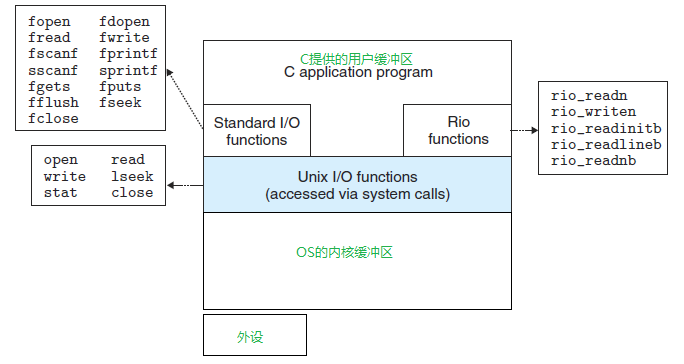4.文件缓冲区
Nevermore 2022-06-03 OS
# 1. 基本理论
缓冲区实际是内存上的一段空间,内存比磁盘具有更快的读写速度,将磁盘的数据读到内存中,可以防止CPU等待读写时间过长。
C语言中,在struct _IO_FILE结构体(通过
grep -ER 'struct _IO_FILE' /usr/include/查找)中还包含了维护了一段缓冲区的结构体信息,这使得由C语言提供的文件读写操作会通过C的缓冲区来实行,即用户级缓冲区。而C语言函数在执行相关的文件操作时,并不会直接操作磁盘上的文件,实际调用的是系统的相关接口,而系统也会为读写操作提供一段缓冲区,称为内核级缓冲区。

- 缓冲区刷新:
进程退出时,会将C语言中FILE维护的缓冲区刷新到系统内核,而内核会自动刷新到磁盘。一些C函数也有刷新缓冲区的功能。
数据从用户到内核的刷新策略又分为:
- 立即刷新不缓存。
- 行缓存,遇到'\n'就刷新本行:显示器打印。
- 全缓存,缓冲区满了才刷新:写入普通文件。
#include <stdio.h>
#include <string.h>
#include <unistd.h>
#include <sys/types.h>
#include <sys/stat.h>
#include <fcntl.h>
int main()
{
close(1);
int fid = open("./test.txt", O_CREAT | O_WRONLY, 0644);
// 关闭文件描述符1,新打开的文件会被重定向到 1,即新文件的文件指针(FILE*)中的文件描述符会
// 置成1,打印到显示器的内容会打印到这个文件
// 由于刷新的目标发生了变化,显示器->文件,则刷新策略也发生了变化,行刷新->全缓存。
fprintf(stdout, "hello world\n");
// FILE 结构体中包含用户级缓冲区
// 对于标准输出(显示器)的缓存区刷新策略是行刷新 '\n'
// 打印到磁盘的文件是全刷新(缓冲区满了才刷新)
// 由于此时的刷新策略是全缓存,此时缓冲区未满,因此文件中看不到字符串。
// fflush(stdout); // 调用函数立即刷新
write(1, "I am father\n", strlen("I am father\n"));//系统调用,没有通过C语言缓冲区写入,直接写入OS缓存
close(fid);
// 原本打印的内容会被存放在C语言缓冲区,程序结束时会被OS刷新到文件缓冲区和磁盘
// 关闭fid,进程退出时找不到维护的文件,则无法将缓冲区的内容刷新到OS,文件内容为空
// 若不关闭fid,即注释掉这句话,在进程退出后,可以看到test.txt文件中打印了"hello world\n"
return 0;
}
1
2
3
4
5
6
7
8
9
10
11
12
13
14
15
16
17
18
19
20
21
22
23
24
25
26
27
28
29
30
31
2
3
4
5
6
7
8
9
10
11
12
13
14
15
16
17
18
19
20
21
22
23
24
25
26
27
28
29
30
31
运行结果:
[test@VM-12-4-centos dup2]$ ./test
[test@VM-12-4-centos dup2]$ cat test.txt
I am father
1
2
3
2
3
# 2. fclose刷新缓冲区
#include <stdio.h>
#include <unistd.h>
int main()
{
FILE* pf = fopen("./test.txt", "w+");
fprintf(pf, "hello world\n");
//close(pf->_fileno); // 若关闭了pf的文件描述符,则无法刷新。
fclose(pf); //进程没有退出,但调用了fclose仍然可以刷新C缓冲到内核
while(1);
return 0;
}
1
2
3
4
5
6
7
8
9
10
11
12
2
3
4
5
6
7
8
9
10
11
12
# 3. 再谈输出重定向
bash中使用>将一个进程在显示器上的输出重定向到一个文件中,本质是调用了系统重定向函数,如dup2。默认只会重定向标准输出,若要重定向标准错误需要特殊指定。而将显示器打印的内容打印到文件中,会使得行缓存变成全缓存,并不会立即刷新,只有进程结束时才会刷新;若此时关闭文件1,进程结束找不到需要刷新的目标文件,则无法打印相应的内容。
#include <stdio.h>
#include <unistd.h>
int main()
{
printf("hello world\n");
close(1);
return 0;
}
1
2
3
4
5
6
7
8
9
2
3
4
5
6
7
8
9
运行结果:
[test@VM-12-4-centos dup2]$ ./test
hello world
[test@VM-12-4-centos dup2]$ ./test > test.txt
[test@VM-12-4-centos dup2]$ cat test.txt
1
2
3
4
2
3
4
# 4. 验证缓冲区
我们知道子进程会继承父进程的数据和代码,包括缓冲区里的数据。通过以上获得的理论结果,也可以将子进程的缓冲区数据进行输出。
#include <stdio.h>
#include <unistd.h>
int main()
{
FILE* pf = fopen("./test.txt", "w+");
fprintf(pf, "hello world\n"); //打印到文件,全缓冲策略
fork();
return 0;
}
1
2
3
4
5
6
7
8
9
10
2
3
4
5
6
7
8
9
10
运行结果:
[test@VM-12-4-centos dup2]$ ./test
[test@VM-12-4-centos dup2]$ cat test.txt # 可以看到"hello world\n"输出了两次
hello world
hello world
# 其中一次是fork的缓冲区在进程结束时刷新到内核的。由于子进程中也有指向pf文件的FILE*,pf的引用计数+1,进程结束时发生了写时拷贝
1
2
3
4
5
2
3
4
5
